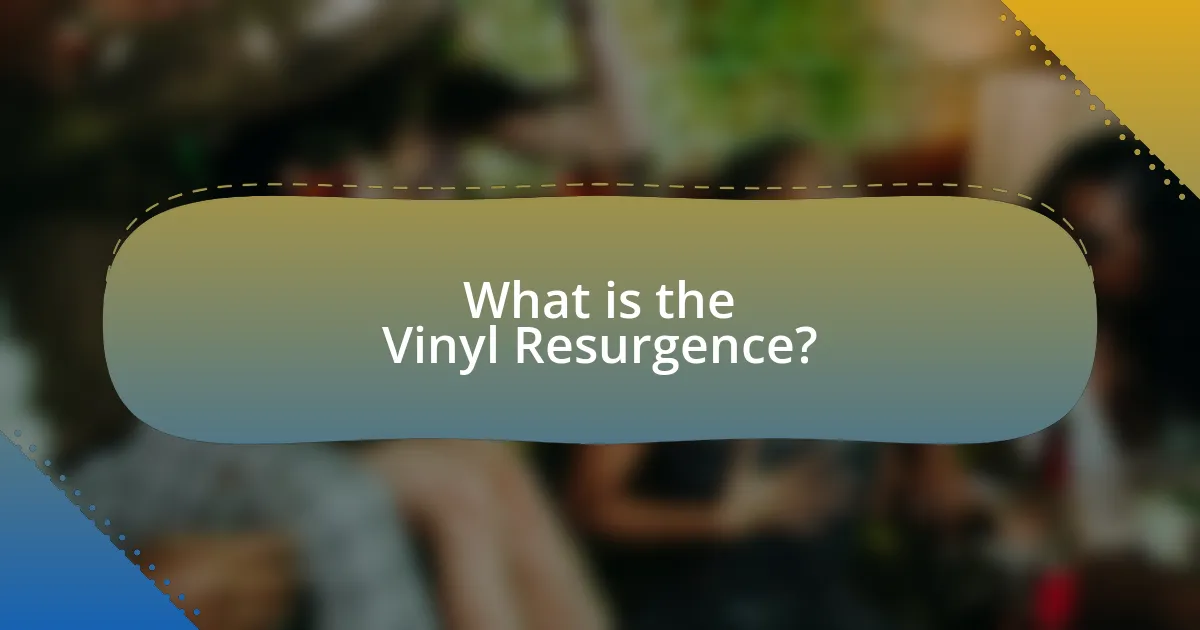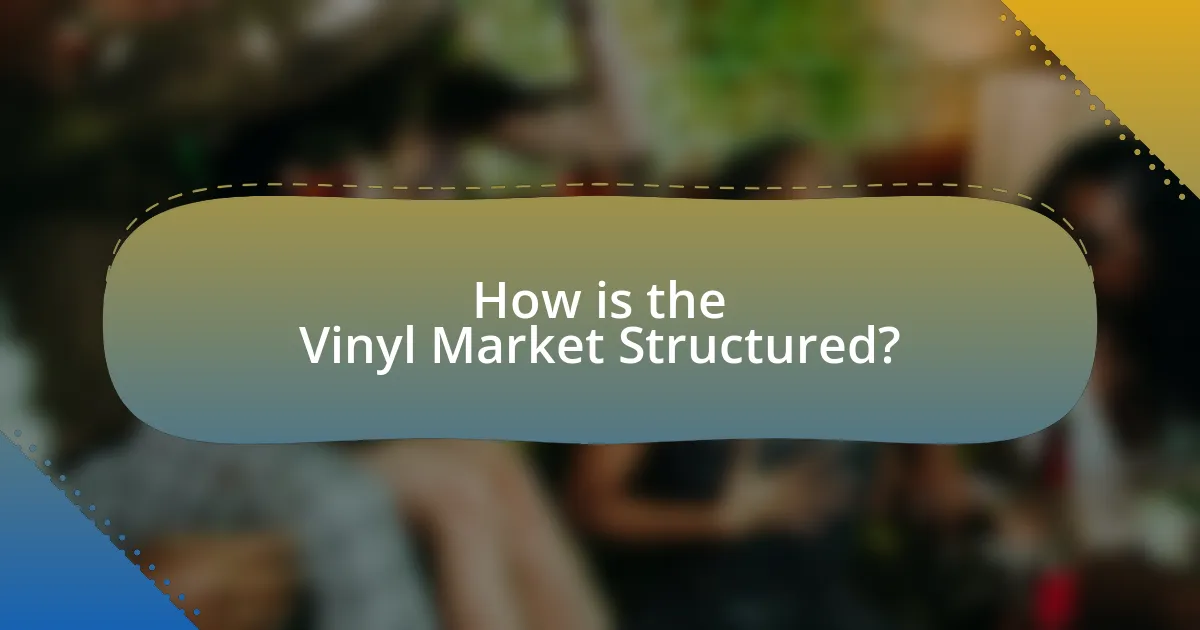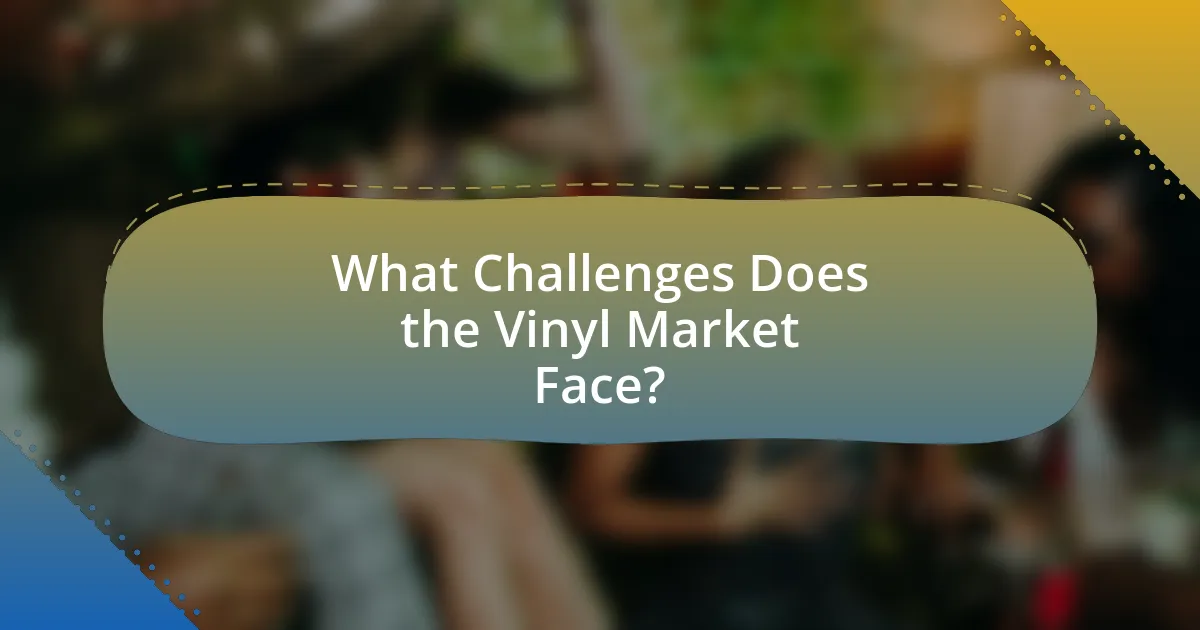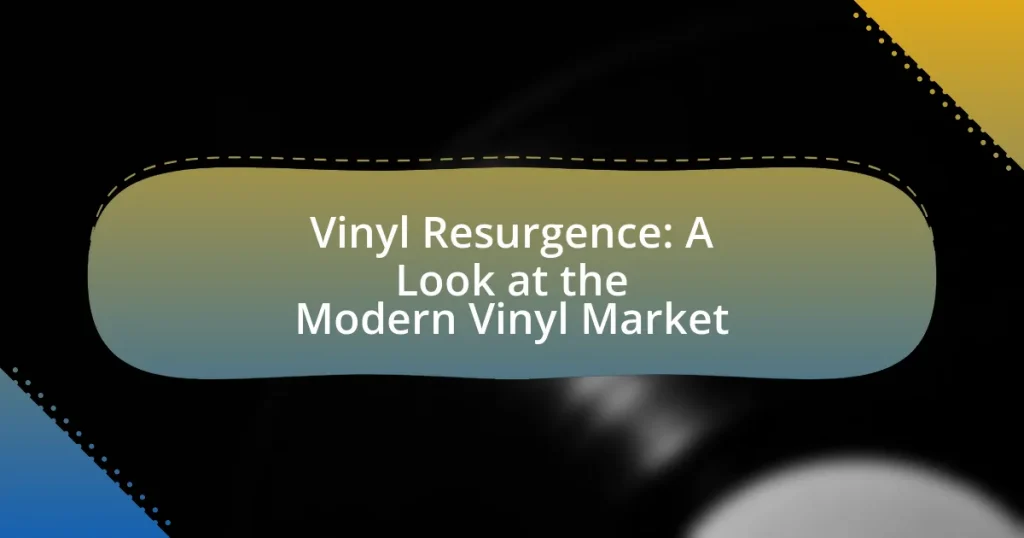The Vinyl Resurgence refers to the significant revival of vinyl records in the music industry, marked by increased sales and consumer interest since 2008. In 2020, vinyl sales surpassed CD sales in the United States for the first time in decades, driven by factors such as nostalgia, the tactile experience of physical media, and a preference for analog sound quality. The article explores the cultural and technological influences behind this trend, the demographics driving the modern vinyl market, and the impact of music genres on sales. Additionally, it examines the structure of the vinyl market, production challenges, and future trends, providing a comprehensive overview of the current state and evolution of vinyl records.

What is the Vinyl Resurgence?
The Vinyl Resurgence refers to the significant revival of vinyl records in the music industry, characterized by increased sales and renewed interest among consumers. Since 2008, vinyl sales have consistently grown, with the Recording Industry Association of America (RIAA) reporting that vinyl sales surpassed CD sales in the United States for the first time in 2020, marking a pivotal moment in music consumption trends. This resurgence is driven by factors such as the tactile experience of vinyl, the appeal of album artwork, and a growing appreciation for analog sound quality.
Why has vinyl become popular again in recent years?
Vinyl has become popular again in recent years due to a combination of nostalgia, the tangible nature of physical media, and the unique sound quality it offers. The resurgence is evidenced by sales data; in 2020, vinyl sales in the United States surpassed CD sales for the first time since the 1980s, with over 27.5 million vinyl records sold, according to the Recording Industry Association of America. This trend reflects a growing consumer preference for the authentic experience of vinyl, as well as the appeal of album artwork and the ritual of playing records.
What cultural factors contribute to the vinyl resurgence?
The cultural factors contributing to the vinyl resurgence include a growing appreciation for analog sound quality, nostalgia for past music experiences, and the desire for tangible music formats. The analog sound quality of vinyl records is often perceived as warmer and richer compared to digital formats, appealing to audiophiles and casual listeners alike. Additionally, nostalgia plays a significant role, as many consumers associate vinyl with their youth or significant cultural moments, driving interest among both older generations and younger listeners seeking authenticity. Furthermore, the rise of independent record stores and vinyl-centric events fosters community engagement and a shared cultural experience, reinforcing the vinyl revival. According to a report by the Recording Industry Association of America, vinyl sales reached a 30-year high in 2020, indicating a strong market demand driven by these cultural factors.
How has technology influenced the revival of vinyl records?
Technology has significantly influenced the revival of vinyl records by enhancing production quality and accessibility. Advances in digital recording and mastering techniques have allowed for higher fidelity sound reproduction, making vinyl more appealing to audiophiles. Additionally, the rise of e-commerce platforms has facilitated easier access to vinyl records, enabling consumers to purchase both new releases and vintage records online. According to the Recording Industry Association of America, vinyl sales reached 41 million units in 2020, the highest level since 1986, demonstrating the impact of these technological advancements on consumer interest and market growth.
What demographics are driving the modern vinyl market?
The modern vinyl market is primarily driven by millennials and Gen Z consumers. These demographics are increasingly purchasing vinyl records due to a growing interest in analog music formats and a desire for tangible music experiences. According to a report by the Recording Industry Association of America (RIAA), vinyl sales reached a record high in 2020, with millennials accounting for a significant portion of these purchases, as they seek nostalgia and authenticity in their music consumption. Additionally, Gen Z’s engagement with vinyl is fueled by social media trends and a preference for unique, collectible items, further solidifying their role in the resurgence of vinyl records.
How do age groups differ in their vinyl purchasing habits?
Age groups differ significantly in their vinyl purchasing habits, with younger consumers, particularly millennials and Gen Z, showing a strong interest in vinyl as a trendy and nostalgic medium, while older generations, such as baby boomers, often purchase vinyl for its historical value and nostalgia. According to a 2021 report by the Recording Industry Association of America (RIAA), vinyl sales among consumers aged 18-34 increased by 29% compared to previous years, indicating a growing trend among younger audiences. In contrast, older age groups tend to buy vinyl primarily for classic albums and collectors’ editions, reflecting their long-standing appreciation for the format. This generational divide highlights the evolving nature of vinyl’s appeal across different demographics.
What role do music genres play in vinyl sales trends?
Music genres significantly influence vinyl sales trends, as consumer preferences for specific genres drive demand for vinyl records. For instance, genres like rock, jazz, and hip-hop have seen substantial growth in vinyl sales, with rock music accounting for approximately 30% of all vinyl sales in 2022, according to the Recording Industry Association of America. Additionally, the resurgence of interest in classic albums and nostalgia for past music eras has led to increased sales in genres that were historically popular, such as classic rock and punk. This trend is further supported by the rise of independent record labels focusing on niche genres, which cater to dedicated fan bases and contribute to the overall growth of vinyl sales.
What are the key characteristics of the modern vinyl market?
The key characteristics of the modern vinyl market include a significant resurgence in popularity, a diverse range of genres and artists, and a focus on high-quality production. The vinyl market has experienced a growth rate of over 30% annually since 2008, with sales surpassing 27 million units in the United States in 2020, according to the Recording Industry Association of America (RIAA). This revival is driven by both nostalgia and the tactile experience vinyl offers, appealing to both older generations and younger listeners. Additionally, the market features limited edition releases and unique artwork, enhancing the collectible aspect of vinyl records. The modern vinyl market also emphasizes sustainability, with many manufacturers adopting eco-friendly practices in production.
How has the production process for vinyl changed?
The production process for vinyl has changed significantly due to advancements in technology and shifts in consumer demand. Modern vinyl manufacturing now utilizes digital cutting techniques, which allow for greater precision and efficiency compared to traditional analog methods. Additionally, the introduction of high-quality materials and improved pressing techniques has enhanced sound quality and durability. For instance, the use of high-grade PVC and better temperature control during pressing has resulted in fewer defects and a more consistent product. These changes reflect the industry’s adaptation to a growing market, which saw vinyl sales increase by 29% in 2020, according to the Recording Industry Association of America.
What are the pricing trends in the current vinyl market?
The current pricing trends in the vinyl market indicate a steady increase in prices, driven by rising demand and limited supply. According to the Recording Industry Association of America (RIAA), vinyl sales reached $1 billion in revenue in 2022, marking a 17% increase from the previous year. This surge in popularity has led to higher production costs, as manufacturers face challenges such as material shortages and increased shipping expenses. Additionally, the average price of a new vinyl record has risen, with many titles now retailing between $25 and $40, reflecting both the collectible nature of vinyl and the investment in quality production.

How is the Vinyl Market Structured?
The vinyl market is structured around several key components, including manufacturing, distribution, retail, and consumer segments. Manufacturing involves pressing plants that produce vinyl records, with major players like GZ Media and MPO leading the industry. Distribution channels include both physical and digital platforms, where records are sold to retailers and directly to consumers. Retail encompasses independent record stores, large retail chains, and online marketplaces, catering to a diverse audience. The consumer segment is characterized by a growing demographic of collectors and casual listeners, driven by a resurgence in vinyl sales, which reached over 41 million units in the U.S. in 2022, according to the Recording Industry Association of America (RIAA). This structured ecosystem supports the increasing demand for vinyl records, highlighting its revival in the music industry.
What types of vinyl records are available today?
Today, the types of vinyl records available include standard 12-inch LPs, 7-inch singles, picture discs, colored vinyl, and audiophile pressings. Standard 12-inch LPs are the most common format, typically containing multiple tracks from an artist or album. 7-inch singles usually feature one song on each side and are popular for collectors. Picture discs are visually appealing records with images printed on the vinyl surface, while colored vinyl offers aesthetic variety with different hues. Audiophile pressings are produced with higher quality materials and processes to enhance sound fidelity, catering to serious music enthusiasts. The resurgence of vinyl has led to a diverse market, with these formats widely available in both new releases and reissues.
What are the differences between new and used vinyl records?
New vinyl records are typically pressed from high-quality materials and are free from scratches or defects, while used vinyl records may show signs of wear, such as surface scratches, pops, or skips. New records often come with a higher price tag due to their pristine condition and the manufacturing process, which includes modern technology for better sound quality. In contrast, used records can vary significantly in condition and price, depending on their age, rarity, and the care they have received over time. Collectors often seek used records for their historical value or unique pressings, while new records appeal to those looking for the best audio experience without imperfections.
How do limited editions impact the vinyl market?
Limited editions significantly enhance the vinyl market by creating scarcity and driving demand among collectors and enthusiasts. This phenomenon is evidenced by the fact that limited releases often sell out quickly, leading to increased resale values; for instance, a limited edition vinyl pressing can appreciate in value by over 200% shortly after release. Additionally, the allure of exclusivity associated with limited editions fosters a sense of urgency among consumers, prompting them to purchase records they might otherwise overlook. This dynamic not only boosts sales for artists and labels but also contributes to the overall growth of the vinyl market, which has seen a resurgence with sales reaching over 41 million units in the U.S. in 2022, according to the Recording Industry Association of America.
What are the major players in the modern vinyl industry?
The major players in the modern vinyl industry include Universal Music Group, Sony Music Entertainment, Warner Music Group, and independent labels like Third Man Records and Record Store Day. Universal Music Group, as the largest music company globally, significantly influences vinyl production and distribution, accounting for a substantial share of the market. Sony Music Entertainment and Warner Music Group also play critical roles, with extensive catalogs and resources dedicated to vinyl releases. Independent labels, such as Third Man Records, founded by Jack White, have contributed to the resurgence of vinyl by focusing on quality and unique releases, while Record Store Day promotes vinyl sales through special releases and events, further driving consumer interest.
Who are the leading record labels in the vinyl resurgence?
The leading record labels in the vinyl resurgence include Universal Music Group, Sony Music Entertainment, and Warner Music Group. These major labels have significantly increased their vinyl production in response to the growing demand for vinyl records, which saw sales reach 41 million units in the U.S. in 2020, the highest level since 1986. Additionally, independent labels such as Third Man Records and Record Store Day have played crucial roles in promoting vinyl culture and supporting artists, further contributing to the resurgence.
What role do independent record stores play in the market?
Independent record stores play a crucial role in the market by serving as vital hubs for music discovery and community engagement. These stores provide a curated selection of vinyl records, often featuring local artists and niche genres that larger retailers may overlook. According to a 2022 report by the Recording Industry Association of America, independent record stores accounted for approximately 30% of vinyl sales in the U.S., highlighting their significant impact on the resurgence of vinyl culture. Additionally, they foster a sense of community by hosting events, live performances, and listening parties, which enhance customer loyalty and promote a deeper connection to music.
How do online platforms influence vinyl sales?
Online platforms significantly boost vinyl sales by providing wider accessibility and targeted marketing. These platforms, such as Bandcamp, Discogs, and various streaming services, allow consumers to discover and purchase vinyl records easily, often featuring exclusive releases and limited editions. According to a report by the Recording Industry Association of America (RIAA), vinyl sales reached a 30-year high in 2020, largely attributed to the convenience and reach of online marketplaces. Additionally, social media platforms facilitate community engagement and promote vinyl culture, further driving interest and sales in the format.
What are the benefits of purchasing vinyl online versus in-store?
Purchasing vinyl online offers several benefits compared to in-store shopping, including a wider selection, convenience, and often better pricing. Online retailers typically stock a more extensive range of titles and editions, including rare and limited releases that may not be available in physical stores. Additionally, shopping online allows consumers to browse and compare prices from multiple retailers without the need to travel, saving time and effort. According to a 2021 report by the Recording Industry Association of America, online sales of vinyl records have surged, indicating a growing preference for digital shopping in this market. Furthermore, online platforms frequently provide discounts and promotions that can lead to lower overall costs for consumers.
How has social media affected vinyl marketing and sales?
Social media has significantly enhanced vinyl marketing and sales by providing platforms for direct engagement between artists and fans. This engagement has led to increased visibility for vinyl releases, as artists can promote new albums and reissues directly to their followers. For instance, a study by the Recording Industry Association of America (RIAA) noted that vinyl sales reached 27.5 million units in 2021, partly driven by social media campaigns that create buzz around new releases. Additionally, platforms like Instagram and TikTok allow users to share their vinyl collections and experiences, further fueling interest and driving sales.

What Challenges Does the Vinyl Market Face?
The vinyl market faces several challenges, including supply chain disruptions, rising production costs, and competition from digital music formats. Supply chain disruptions have been exacerbated by global events, leading to delays in the availability of raw materials necessary for vinyl production. Rising production costs, particularly for vinyl pellets and labor, have impacted pricing and profit margins for manufacturers. Additionally, competition from digital music formats continues to pose a threat, as consumers increasingly favor convenience and accessibility over physical media. According to the Recording Industry Association of America, while vinyl sales have surged, they still represent a fraction of overall music consumption, highlighting the ongoing challenge of maintaining market share against digital alternatives.
What are the production challenges in the vinyl industry?
The production challenges in the vinyl industry include limited manufacturing capacity, supply chain disruptions, and the high cost of raw materials. Limited manufacturing capacity arises from a shortage of pressing plants, which has been exacerbated by the resurgence in vinyl popularity, leading to longer wait times for production. Supply chain disruptions, particularly during the COVID-19 pandemic, have affected the availability of essential materials like PVC and colorants, causing delays and increased costs. Additionally, the high cost of raw materials has been driven by global market fluctuations, impacting the overall pricing and profitability of vinyl records.
How do supply chain issues affect vinyl availability?
Supply chain issues significantly reduce vinyl availability by disrupting the production and distribution processes. For instance, delays in raw material sourcing, such as PVC, and transportation bottlenecks can lead to longer lead times for manufacturing records. According to a report by the Recording Industry Association of America, the vinyl record market has seen a resurgence, but supply chain constraints have resulted in shortages, causing delays in new releases and increased prices. These factors collectively hinder the ability of manufacturers to meet consumer demand, thereby affecting overall vinyl availability in the market.
What environmental concerns are associated with vinyl production?
Vinyl production is associated with several environmental concerns, primarily due to the use of polyvinyl chloride (PVC) as a key material. The production of PVC involves the release of harmful chemicals, including dioxins, which are known to be toxic and can accumulate in the food chain. Additionally, the manufacturing process generates significant greenhouse gas emissions, contributing to climate change. According to a study by the European Commission, PVC production is responsible for approximately 0.5% of global greenhouse gas emissions. Furthermore, the disposal of vinyl products poses challenges, as they are not biodegradable and can lead to long-term pollution in landfills.
How does the vinyl market compete with digital music formats?
The vinyl market competes with digital music formats by offering a unique auditory experience and tangible product that digital formats cannot replicate. Vinyl records provide a warmer sound quality due to their analog nature, which many audiophiles prefer over the compressed audio of digital formats. Additionally, the physicality of vinyl—its large artwork, the act of placing a record on a turntable, and the ritual of listening—creates a more immersive experience. According to the Recording Industry Association of America (RIAA), vinyl sales reached 41 million units in 2020, marking the highest sales since 1986, indicating a strong consumer preference for vinyl despite the dominance of digital music. This resurgence highlights how the vinyl market effectively appeals to nostalgia and the desire for a more engaging music experience, setting it apart from the convenience of digital formats.
What unique value does vinyl offer compared to streaming services?
Vinyl offers a tactile and immersive listening experience that streaming services cannot replicate. The physical nature of vinyl records allows listeners to engage with the music through the act of handling the record, placing it on a turntable, and experiencing the analog sound quality, which many enthusiasts argue is warmer and richer than digital formats. Additionally, vinyl records often come with large-format artwork and packaging that enhance the overall aesthetic experience, making them collectible items. According to a 2020 report by the Recording Industry Association of America, vinyl sales surpassed CD sales for the first time since the 1980s, indicating a significant consumer preference for the unique value that vinyl provides over digital streaming options.
How do consumer preferences shift between formats?
Consumer preferences shift between formats primarily due to factors such as nostalgia, perceived audio quality, and the tactile experience associated with physical media. For instance, the resurgence of vinyl records can be attributed to a growing appreciation for analog sound, which many listeners perceive as warmer and richer compared to digital formats. According to a report by the Recording Industry Association of America (RIAA), vinyl sales in the U.S. reached 41 million units in 2020, marking the highest level since 1986, indicating a significant shift in consumer preference towards this format. Additionally, the physicality of vinyl, including album artwork and the ritual of playing records, enhances the overall experience, further driving consumer interest away from purely digital formats.
What are the future trends for the vinyl market?
The future trends for the vinyl market indicate continued growth and diversification. The global vinyl record market is projected to reach approximately $1 billion by 2025, driven by increasing consumer interest in analog music formats and the resurgence of vinyl as a collectible item. Additionally, the rise of independent record labels and artists releasing music on vinyl is expanding the market, with sales of vinyl records in the U.S. surpassing CD sales for the first time in 2020, according to the Recording Industry Association of America (RIAA). Enhanced audio quality and unique packaging are also attracting new listeners, further solidifying vinyl’s position in the music industry.
How might technology further influence vinyl production and sales?
Technology may further influence vinyl production and sales by enhancing manufacturing processes and expanding distribution channels. Advanced digital tools, such as computer-aided design and automated pressing machines, can improve the precision and efficiency of vinyl record production, leading to higher quality outputs and reduced production times. For instance, the introduction of 3D printing technology in vinyl manufacturing allows for rapid prototyping and customization, catering to niche markets and personalized consumer preferences. Additionally, online platforms and e-commerce solutions facilitate direct-to-consumer sales, enabling independent artists and labels to reach wider audiences without traditional retail barriers. According to the Recording Industry Association of America (RIAA), vinyl sales in the U.S. reached 41 million units in 2020, demonstrating a significant market demand that technology can help meet through improved accessibility and production capabilities.
What strategies can businesses adopt to thrive in the evolving vinyl market?
Businesses can thrive in the evolving vinyl market by focusing on niche marketing, enhancing product quality, and leveraging digital platforms for sales and promotion. Niche marketing allows businesses to target specific consumer segments, such as audiophiles or collectors, which can lead to increased customer loyalty and higher sales. Enhancing product quality, including offering limited editions or unique pressings, can differentiate products in a competitive market. Additionally, leveraging digital platforms, such as social media and e-commerce websites, enables businesses to reach a broader audience and engage with customers effectively. According to the Recording Industry Association of America, vinyl sales reached a record high in 2020, indicating a growing consumer interest that businesses can capitalize on through these strategies.
What tips can consumers follow when buying vinyl records?
Consumers should consider the condition of the vinyl record, as it significantly affects sound quality and value. When buying, inspect for scratches, warps, and dirt, as these can impact playback. Additionally, purchasing from reputable sellers or established record stores ensures authenticity and quality, reducing the risk of counterfeit products. Researching the pressing history of the album can also provide insight into its value; for example, first pressings often hold more value among collectors. Finally, checking for proper packaging and inserts can indicate the overall care taken with the record, which is a good sign of its quality.












